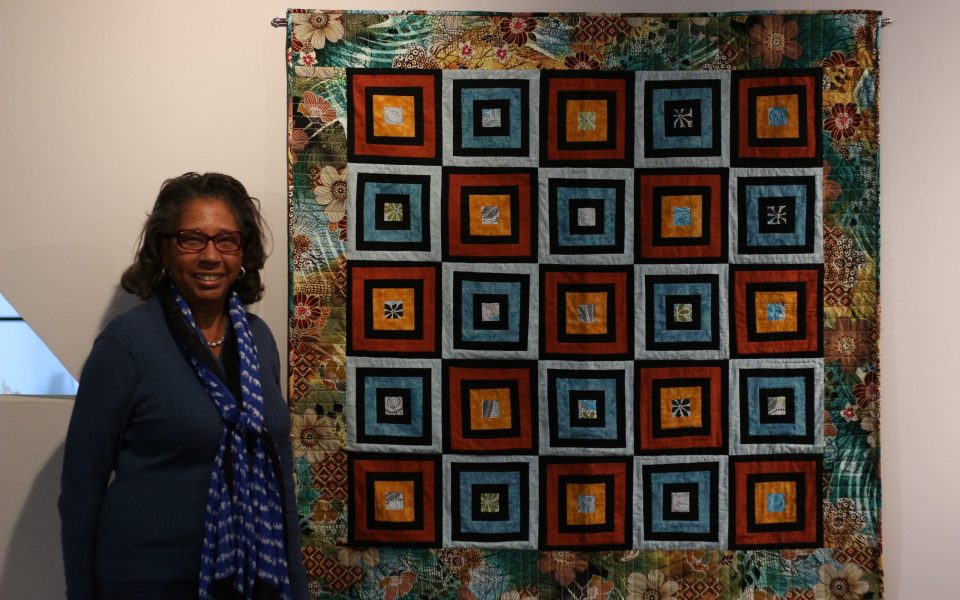Evil travels in straight lines, so stay on the drunkard’s path; cover your trail. Follow the geese north in spring. Take the sailboat across the Great Lakes to the North Star above Canada.
At the end of an interview near the gallery entrance, quilter Peggy Moore revealed the meaning behind each pattern on the Underground Railroad replica quilt, an essential part of the Raw Edges exhibit at the Delta Arts Center in East Winston-Salem. The sampler quilt contains 15 traditional patterns, ones that some historians believe may have served as communication between slaves on their way to freedom.
From Jan. 17 to April 8, the Delta Arts Center — a nonprofit organization that engages in cultural, educational and public service activities — presents diverse textile art by local African-American quilters.
Whether or not the patterns contained clues doesn’t alter the enormous role that textiles have played and continue to play in African-American communities. Throughout the country, educators have adapted Underground Railroad quilts into lesson plans in order to study history through art. The drunkard’s path — a meandering route often represented by sewing a concave curve to a convex curve — provides an archaic example: Many African tribes believed a break in a pattern symbolized rebirth and power; if evil travels in straight lines, a break baffles and delays the spirits. It’s easy to draw a parallel to white men hunting the escaping slaves’ entangled trail.
As pieces of folklore, both historical and contemporary quilts ask an important question: How do we talk to one another through these artifacts we leave behind?
It was the question on director Nadiyah Quander’s mind as she searched for ways to exhibit art that proves “more intimate, under the skin and off the wall.”
Quander praised the different reasons that the women behind the beautiful pieces began quilting: storytelling, memories and oral histories.
“It’s an opportunity for those who may not consider themselves artists to share their work and stories,” she said. “The results are enriching and unexpected.”
Of all the quilts in the exhibit, Roslyn Spiener-Jones’ masterpiece “Big Daddy” best exemplifies the desire to express memory and reverence. Spiener-Jones created the quilt from a picture of her grandfather, sitting with a hat tilted low over his eyes, a staff in his hand and pipe in his mouth. Quander called the stunning result “a textile monument,” harkening the desire to revere someone and communicate their life to others. It’s an invitation to inquire, even privately, into the life of the man portrayed in fabric and string.
Using collage-style quilting — small and disparate pieces, as opposed to large, balanced squares and angels — Spiener-Jones chose black, white and gray-blue fabrics to impart a colorless antiquity to her modern, wall-hanging creation.
[pullquote]Raw Edges can be seen at the Delta Arts Center in East Winston-Salem through April 8.[/pullquote]
Elsewhere in the exhibit, traditions abound.
In a very fortunate opportunity, Peggy Moore provided a personal tour of the hanging quilts and her own history as a textile artist.
She began at her quilt, a floral border filled with bright, floating trimmings of light blue, orange and black. Those squares are complete with small pieces of an old blouse that she cut up to finalize her work’s gorgeous aesthetic.
Moore then walked to her aunt’s quilt. Decades ago in Mocksville, Moore’s aunt hand-stitched a bed-sized quilt with 30 differently colored eight-point stars that allude to the traditional North Star pattern.
According to Moore, the creation of the polyester quilt was far more complicated than it seems. “Polyester holds its colors, doesn’t fade, but it’s horrific to sew, unlike cotton,” she said. “Heat affects it poorly, too.”
Moore thought the different fabrics might include the clothing that her aunt’s daughters outgrew, or different men’s suits that were popular at the time.
Her tour ended with a quilt inspired by the first African-American fraternity, an important link to the Delta Arts Center’s own sorority origin: “Delta Fine Arts began as a project of the Winston-Salem Alumnae Chapter of Delta Sigma Theta Sorority,” the organization states, “in response to a community need for expanded arts and humanities programming.”
The mother of an Alpha Phi Alpha member fashioned a piece to celebrate her son’s membership in the first black fraternity.
The emblems on the quilt — honor, respect, protect — mirror the Delta Arts Center’s ambition of social action and involvement, another example of the inseparable union between cultural and artistic preservation.
Join the First Amendment Society, a membership that goes directly to funding TCB‘s newsroom.
We believe that reporting can save the world.
The TCB First Amendment Society recognizes the vital role of a free, unfettered press with a bundling of local experiences designed to build community, and unique engagements with our newsroom that will help you understand, and shape, local journalism’s critical role in uplifting the people in our cities.
All revenue goes directly into the newsroom as reporters’ salaries and freelance commissions.





Leave a Reply